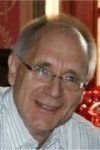Prof. Dr. Matthias SCHNÜRER
Prof. Matthias SCHNÜRER
Image: PrivateMatthias Schnürer, a senior scientist (department head) at Max-Born-Institut in Berlin (Germany), is visiting the Faculty of Physics and Astronomy as an ASP Visiting Professor in 2012. During his stay he will give a series of three lectures on modern problems in optics, starting on January 6th.
Matthias Schnürer received his Habilitation at Technical University Vienna in 2001. Currently, he is working as a senior scientist at Max-Born-Institut in Berlin. His present work is focused on laser driven particle acceleration, on which he leads different projects. After his diploma and PhD work in experimental solid state physics (1982 and 1984 at Humboldt University in Berlin), M. Schnürer started research in the field of laser matter interaction. During all these years, he got experience with different laser systems and pulse power spanning more than 6 orders of magnitude. Laser plasma phenomena as incoherent x-ray emission, coherent EUV- generation with plasma based lasers, high harmonic generation, and now relativistic laser plasma dynamics are stations of his research.
Lecture 1: Laser Acceleration Experiments: Experimental Techniques & Measurement of Strong Fields
Time: January 6, 2012, 14:00
Place: Fraunhofer IOF Jena, Albert-Einstein‐Str. 7, 07745 Jena
In this lecture some basic prerequisites for experiments with very high intensity laser pulses aiming for laser-plasma interaction phenomena are introduced. This comprises the temporal contrast of a laser pulse, focusing to highest light intensities and optical beam synchronization. Techniques of contrast shaping and focus improvement are discussed and examples from recent laser-plasma experiments are given.
Particle acceleration with lasers is an intensively studied topic and within this course techniques of ion detection in spectrometers as well as in imaging setups with ion pulses will be looked at. Due to their properties laser accelerated ion pulses are an ideal tool for measurement of strong electric and magnetic fields. Examples from actual research projects are given which are e.g. pump-probe experiments with relativistic light intensities. This lecture focuses on experimental techniques. Underlying concepts in laser- plasma physics, especially particle acceleration, will be presented in two following talks.
Audience: upper level undergraduate seniors, graduate students majoring in optics, physics
Pre-requisites: introduction in laser physics, optics, basics of electro-magnetic fields
Lecture 2: Strong Fields in Laser Plasmas: Electron Kinematics and Laser Absorption
Time: January 20, 2012, 11:15
Place: IOQ meeting room, Max-Wien-Platz 1, 07743 Jena
Starting from an intuitive view to qualify a strong field the kinematic of electrons in intense laser fields is looked at. Important measures such as the ponderomotive potential and parameters of plasma are introduced. Understanding of propagation of electromagnetic waves (laser light) in a plasma is a prerequisite for description of energy transfer processes, laser light absorption in plasmas and the built up of strong fields. Collisional and non-collisional processes are discussed. Terms and phenomena presented in this lecture are used for the next follow-up discussion of laser particle acceleration.
Audience: upper level undergraduates, graduate students majoring in optics, physics
Pre-requisites: introduction in laser physics, optics, basics of electro-magnetic fields
Lecture 3: Strong Fields in Laser Plasmas: Principles of Laser-Particle-Acceleration
Time: January 27, 2012, 11:15
Place: IOQ meeting room, Max-Wien-Platz 1, 07743 Jena
Creation of fast ions and electrons is a fascinating consequence of strong fields in laser plasmas. Currently much effort is spent to explore possible routes of this new type of particle acceleration. In this lecture two schemes of ion acceleration, namely Target Normal Sheath Acceleration (TNSA) and Radiation Pressure Acceleration (RPA), are looked at. While TNSA is already used in application experiments RPP is in the focus of current research. Some examples are also presented. Finally a short glimpse to electron acceleration is done.
Audience: upper level undergraduates, graduate students majoring in optics, physics
Pre-requisites: introduction in laser physics, optics, basics of electro-magnetic fields
